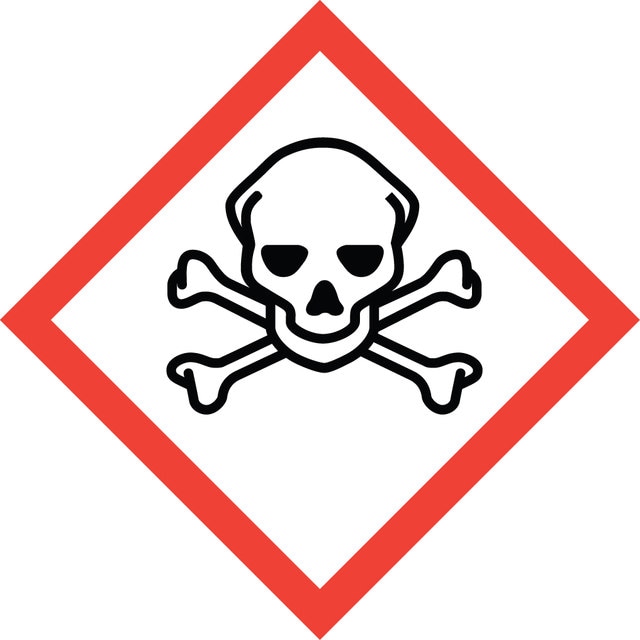Sign In to View Organizational & Contract Pricing
Select a Size
About This Item
Empirical Formula (Hill Notation):
C8H8O2
CAS Number:
Molecular Weight:
136.15
Beilstein:
2041348
EC Number:
MDL number:
UNSPSC Code:
12352100
PubChem Substance ID:
NACRES:
NA.22
Assay
≥98.0%
mp
123-125 °C
solubility
toluene: soluble 0.5 g/10 mL, clear to faintly turbid, yellow to brown
functional group
ketone
SMILES string
CC1=CC(=O)C(C)=CC1=O
InChI
1S/C8H8O2/c1-5-3-8(10)6(2)4-7(5)9/h3-4H,1-2H3
InChI key
MYKLQMNSFPAPLZ-UHFFFAOYSA-N
General description
2,5-Dimethyl-1,4-benzoquinone is a quinone derivative. Its reaction with jack bean urease in phosphate buffer, pH 7.8 has been studied. It is present as one of the component of defensive secretion of opilionid Acanthopachylus aculeatus. It has been investigated as inhibitor of jack bean urease in 50mM phosphate buffer, pH 7.0.
Application
2,5-Dimethyl-1,4-benzoquinone may be used in a key step involved in the total synthesis of (−)-cyathin A3.
Signal Word
Danger
Hazard Statements
Precautionary Statements
Hazard Classifications
Acute Tox. 3 Oral - Eye Irrit. 2 - Skin Irrit. 2 - STOT SE 3
Target Organs
Respiratory system
Storage Class Code
6.1C - Combustible acute toxic Cat.3 / toxic compounds or compounds which causing chronic effects
WGK
WGK 3
Flash Point(F)
Not applicable
Flash Point(C)
Not applicable
Personal Protective Equipment
dust mask type N95 (US), Eyeshields, Gloves
Choose from one of the most recent versions:
Already Own This Product?
Find documentation for the products that you have recently purchased in the Document Library.
J Cao et al.
Biochimica et biophysica acta, 1015(2), 180-188 (1990-02-02)
Upon illumination, a dark-adapted photosynthetic sample shows time-dependent changes in chlorophyll (Chl) a fluorescence yield, known as the Kautsky phenomenon or the OIDPS transient. Based on the differential effects of electron acceptors such as 2,5-dimethyl-p-benzoquinone (DMQ) and 2,6-dichloro-p-benzoquinone (DCBQ) on
M Floreani et al.
The Journal of pharmacology and experimental therapeutics, 260(2), 468-473 (1992-02-01)
In guinea pig and rat cardiac tissue, redox cycling benzoquinones (2,5-dimethyl-p-benzoquinone and duroquinone) and naphthoquinones (menadione and 2,3-dimethoxy-1,4-naphthoquinone) generated superoxide anion (O2-.) both through one- and two-electron reductions, the generation being significantly greater in guinea pig than in rat tissue.
Wiesława Zaborska et al.
Journal of enzyme inhibition and medicinal chemistry, 17(4), 247-253 (2003-01-18)
1,4-benzoquinone (BQ) and 2,5-dimethyl-1,4-benzoquinone (DMBQ) were studied as inhibitors of jack bean urease in 50 mM phosphate buffer, pH 7.0. The mechanisms of inhibition were evaluated by progress curves studies and steady-state approach to data achieved by preincubation of the
S Kumazawa et al.
Journal of bacteriology, 154(1), 185-191 (1983-04-01)
Whole cells of photoanaerobically grown Chromatium sp. strain Miami PBS1071, a marine sulfur purple bacterium, oxidized H2 in the dark through the oxyhydrogen reaction at rates of up to 59 nmol of H2 per mg (dry weight) per min. H2
Oana Cramariuc et al.
Journal of molecular modeling, 19(2), 697-704 (2012-09-27)
The effect of a strong electric field generated by molecular dipoles on the ground state electronic structure and the Q and B states as well as the lowest charge transfer (CT) excited state of porphine-2,5-dimethyl-1,4-benzoquinone (PQ) complex has been investigated
Our team of scientists has experience in all areas of research including Life Science, Material Science, Chemical Synthesis, Chromatography, Analytical and many others.
Contact Technical Service